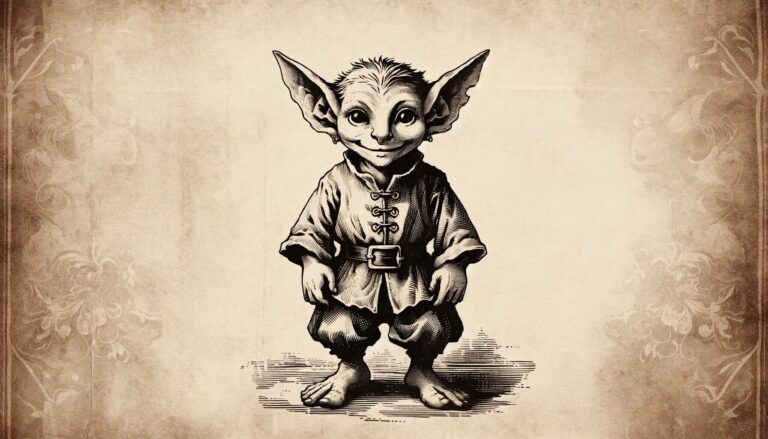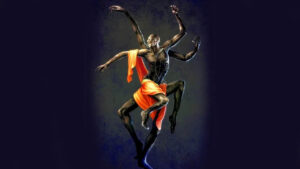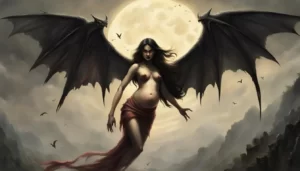Table of Contents
In the charming villages of Teutonic Germany, nestled amidst lush woodlands and picturesque landscapes, a peculiar and enduring legend unfolds—the legend of the Kobold. These mystical creatures, known for their mischievous yet helpful nature, have been a part of German folklore since the 13th century. As we delve into the world of the Kobold, we uncover their origins, history, and the intriguing facets that define their existence.
Beginnings
The story of the Kobold begins in the heart of Germany, where they originated as small helper spirits. These benevolent beings were initially found amidst the woods, but they soon became intertwined with human households. The connection between humans and Kobolds was forged through offerings to the boxwood tree and carvings dedicated to these spirits. The intent was simple: by creating a talisman for the house and making offerings, one could attract a Kobold to assist with chores and daily tasks.
Imagine the delight of those who embarked on this mystical journey two decades ago, hoping to make life easier with a Kobold’s help. Little did they know that their well-intentioned gesture would take an unexpected turn, as the Kobold they welcomed into their homes would bring chaos instead of order. Dishes were broken, vegetables destroyed, and life became far from the peaceful existence they had envisioned.
The reason behind this unexpected shift in behavior? A simple act of moving the carving dedicated to the Kobold had incited its anger. All the years spent crafting delicate clothes as gifts had been overshadowed by a single act, turning their once-helpful companion into a tormentor.
Efforts to rid themselves of the Kobold proved futile, as it stubbornly clung to its newfound role as a household nuisance. Desperate times called for desperate measures, and some contemplated the last resort—a potential exorcism.
Origins
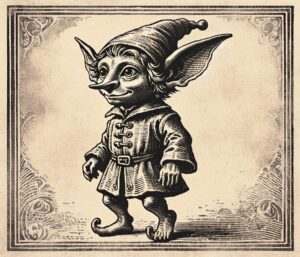
Kobolds have their roots firmly planted in Teutonic Germany, where they made their presence known as early as the 13th century. These enigmatic creatures are believed to hail from the realm of spirits or the faerie world, primarily dwelling in woods or mines. While they started as helpers, their nature took a twist when they formed lasting bonds with specific humans or places. Once attached, they became unyielding, refusing to leave and transforming into mischievous pranksters if provoked.
A Trio of Varieties
In the rich tapestry of Kobold folklore, three distinct types emerge, each associated with a unique domain:
1. Household Helpers: These Kobolds were enticed from the woods they inhabited through offerings made at their sacred tree and carvings etched onto homes that sought their presence. They were the precursors to house spirits, and their initiation into a household was marked by patience and dedication. Offerings of honey or water were made to win their favor. Success was indicated by branches falling at the petitioner’s feet, signifying that the Kobold would follow them home, forever assisting in various tasks.
2. Subterranean Dwellers: Unlike their woodland counterparts, mine Kobolds lived in communities or kingdoms beneath the earth’s surface. Their ability to turn invisible came in handy when encountering undesired intruders, allowing them to vanish at will. When a mine Kobold developed a liking for a human visitor, they would secretly follow them home, aiding with chores and using their magical abilities for the miners’ benefit. In mines, they were known to be guides, knocking to reveal the presence of valuable veins. However, their nature could range from beneficial to troublesome, as they were also blamed for accidents and mischief.
3. Klabautermann of the High Seas: Klabautermann, a special breed of Kobolds, found their abode on ships, assisting with various tasks essential for sailing. Their role was especially vital during challenging times when they tirelessly worked to maintain the ship. They hammered at leaks until the crew could repair them properly and arranged cargo efficiently. However, sighting a Klabautermann was considered an ominous omen, often foreshadowing imminent death—either the observer’s or the entire ship’s doom.
The Mood Swings
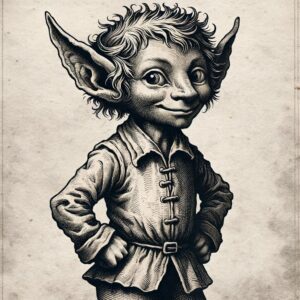
Kobolds, at their core, are predisposed to help humans. Yet, their cooperation hinges on appreciation. Regular offerings are essential to demonstrate gratitude for their assistance. When the Kobolds feel neglected or ignored, their mood sours, and their benevolence transforms into mischief.
These house spirits have a unique way of displaying their annoyance. Milk that once turned into butter during the night may inexplicably sour. Thatch from roofs could be pulled away, demanding immediate repairs. On ships, ropes and sails might become tangled, and the crew could be distracted by laughter and jeers. In mines, Kobolds with typically beneficial tendencies may adopt the characteristics of their malevolent counterparts described earlier, though they rarely inflict harm.
Even an angry Kobold is not considered dangerous. They will cause all manner of mischief, but will not generally cause outright harm to humans.
Appearance
Kobolds are often depicted as small, humanoid creatures, standing at about two to three feet tall. They are known for their diminutive stature and their ability to change shape. When they transform into human-like beings, they remain short in stature.
These creatures are sometimes described as having a stocky build, with strong and sturdy bodies. Their skin is typically depicted as rough and earthy, resembling the colors of the terrain they inhabit. Kobolds’ skin tones can range from shades of brown to gray or green, allowing them to blend seamlessly into their surroundings.
One distinctive feature of Kobolds is their glowing, fiery eyes, which are said to shine with an otherworldly light. Their eyes are often portrayed as their most prominent facial feature, giving them an eerie and mischievous appearance.
Kobolds’ hair is usually described as long and shaggy, often shaped in a bowl cut style. They may have hair colors that complement their natural surroundings, further aiding in their ability to camouflage themselves.
Despite their small stature, Kobolds are known for their agility and quick movements. This allows them to navigate the intricate underground tunnels of mines or move stealthily through the woods. When in their true forms, they may have webbed hands and feet, which aids in their swimming abilities.
Kobolds’ ability to shape-shift and turn invisible also makes them elusive and difficult to spot, especially when they choose to remain hidden from human sight.
The Enduring Legacy

Kobolds remain important in German folklore as house spirits, guardians of the homes they inhabit. They can be most easily coaxed to your home on Midsummer’s Eve, and unlike most other house spirits they appreciate gifts. Clothing is their favorite, and is certain to keep a Kobold from feeling neglected or underappreciated.
The legend of the Kobold endures in German culture, serving as a reminder of the intricate bond between humans and the supernatural world. As guardians of the home, Kobolds symbolize the connection between the everyday realm and the mystical, unseen forces that shape our lives. Their tales continue to captivate the imagination, emphasizing the importance of respect, gratitude, and harmony with nature.
In modern times, the legacy of the Kobold lives on in various forms. Literature and art often draw inspiration from these mystical beings, weaving their mischievous yet endearing qualities into stories and visual representations. They serve as a source of fascination for those intrigued by folklore and mythology, offering a glimpse into a world where the ordinary and extraordinary coexist.
Kobolds also find their way into contemporary culture through adaptations in gaming and fantasy realms. Role-playing games and fantasy literature frequently feature Kobold-like creatures, each with its own unique characteristics and abilities. These adaptations pay homage to the enduring appeal of these supernatural entities and their ability to evoke a sense of wonder and curiosity.
In closing, the Kobold’s enduring legacy reminds us that the boundary between reality and the supernatural is often thinner than we realize. These mischievous yet benevolent beings continue to be a source of fascination, offering a bridge to a world where magic, mystery, and everyday life intersect, reminding us of the importance of cherishing the unseen forces that shape our world.
FAQ
Are Kobolds friendly or mischievous?
Kobolds are typically helpful and friendly, especially when appreciated and offered gifts. However, if they feel neglected or offended, they can become mischievous and cause problems.
How can one attract a Kobold to their home?
To attract a Kobold to your home, offerings of honey or water can be made at their tree. If the Kobold accepts, branches may fall at your feet, signifying their presence. They will then follow you home.
Are there different types of Kobolds?
Yes, there are three main types of Kobolds: household helpers, mine Kobolds, and Klabautermann. Each has its unique characteristics and domain of influence.
What happens when a Kobold becomes offended?
When offended, Kobolds may reverse their helpful actions and cause mischief. For example, they might sour milk, damage thatch roofs, or distract ship crews. However, they rarely cause harm.
How has the Kobold legend influenced modern culture?
The Kobold legend has left its mark on literature, art, gaming, and fantasy realms. They continue to inspire creativity and fascination, serving as a bridge between the ordinary and the supernatural.
When is the best time to coax a Kobold into your home?
Midsummer's Eve is considered an opportune time to attract a Kobold to your home, as it aligns with certain traditions and folklore associated with these creatures.
What gifts do Kobolds appreciate?
Kobolds are particularly fond of clothing as gifts. Offering them clothing is a way to show appreciation and keep them from feeling neglected.
Can Kobolds be harmful?
While Kobolds may cause mischief and inconvenience when offended, they are not generally considered dangerous and do not cause severe harm to humans.
